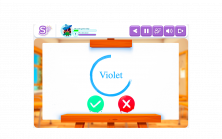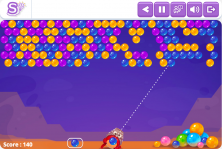Today we will talk about SmartickBrain, Smartick’s cognitive training platform that students can access after completing their daily session. It is full of games specifically designed to improve four different cognitive areas: memory, reasoning, attention, and flexibility. SmartickBrain stimulates, trains and improves these skills through online games.
Cognitive areas
- Memory is the cognitive capacity to code, save, and recover information.
- Reasoning is an important component of fluid intelligence. It is the capacity to adapt and face new situations in a flexible way.
- Attention is the ability to regulate our behavior so that we can avoid distracting actions and focus on meeting our goals.
- Flexibility is the mental ability to switch between thinking about two different concepts and to think about multiple concepts simultaneously.
Several researchers around the world have shown that math skills and academic achievement are related to these general cognitive skills (Bull & Scerif, 2001; Sortor & Kulp, 2003; Alloway & Passolunghi, 2011). Additionally, children who have participated in cognitive training programs focused on general cognitive abilities, such as those included in SmartickBrain, have been shown to have improved their math and reading skills (Wexler et al. 2016).
Today, we are going to primarily focus on SmartickBrain’s flexibility games.
Flexibility
The term “cognitive flexibility” refers to our ability to switch between different mental sets, tasks, or strategies (Miyake & Friedman, 2012). This skill is one of the main executive functions and allows us to adapt our behavior to the situation so we can achieve the best outcomes. It plays an important role in both daily life and learning, however, some children with learning and attention difficulties may struggle with flexible thinking. Therefore, the SmartickBrain flexibility games are not only fun for kids, but also potentially valuable to improve their math skills and academic performance.
In order to boost cognitive flexibility, a game should involve the ability to shift between response sets, learn from errors, generate alternative strategies, divide attention, and concurrently process information (Anderson, 2002). Now, let’s have a look at two flexibility games included in SmartickBrain.
Cognitive training games for flexibility
- Color Splash! is a game designed to train divided attention, an important component of mental flexibility. Children have to click on the green button if the word presented on the screen and its meaning are the same color, if not they should click on the red button. But they have to do it fast because they have only a few seconds to give their answer!

- Ball pang! is another fun game that children can play to perfect their mental flexibility and spatial reasoning skills. The objective is to eliminate all of the colored balls as quickly as possible and before they reach the bottom of the screen. To do this, they have to connect three or more balls of the same color.

The students that do Smartick can access games like these every day after they have completed their 15-minute daily session. Register with Smartick and try it for free.
References:
- Anderson, P. (2002). Assessment and development of executive function (EF) during childhood. Child neuropsychology, 8(2), 71-82.
- Alloway, T. P., & Passolunghi, M. C. (2011). The relationship between working memory, IQ, and mathematical skills in children. Learning and Individual Differences, 21(1), 133-137.
- Bull, R., & Scerif, G. (2001). Executive functioning as a predictor of children’s mathematics ability: Inhibition, switching, and working memory. Developmental neuropsychology, 19(3), 273-293.
- Miyake, A., & Friedman, N. P. (2012). The nature and organization of individual differences in executive functions: Four general conclusions. Current directions in psychological science, 21(1), 8-14.
- Sortor, J. M., & KULP, M. T. (2003). Are the results of the Beery-Buktenica Developmental Test of Visual-Motor Integration and its subtests related to achievement test scores?. Optometry and vision science, 80(11), 758-763.
- Wexler, B. E., Iseli, M., Leon, S., Zaggle, W., Rush, C., Goodman, A., Imal, A. E., & Bo, E. (2016). Cognitive Priming and Cognitive Training: Immediate and Far Transfer to Academic Skills in Children. Nature: Scientific Reports 6(32859), 1-9.
Learn More:
- Lost Objects: The New SmartickBrain Game to Train Attention
- Educational Games on SmartickBrain, Essential for Learning
- Cognitive Flexibility: Benefits and Training with Smartick Brain Games
- Searching for Fun Activities for Your Kids This Summer?
- Reasoning Games to Improve Mathematics
- Mistakes: An Opportunity to Learn - 05/07/2020
- The Importance of Positive Reinforcement in Education - 04/02/2020
- Is It True That Boys Are Better at Math Than Girls? - 03/05/2020







